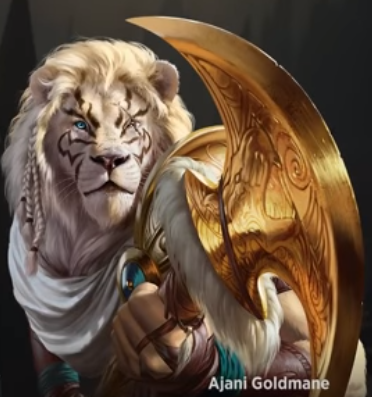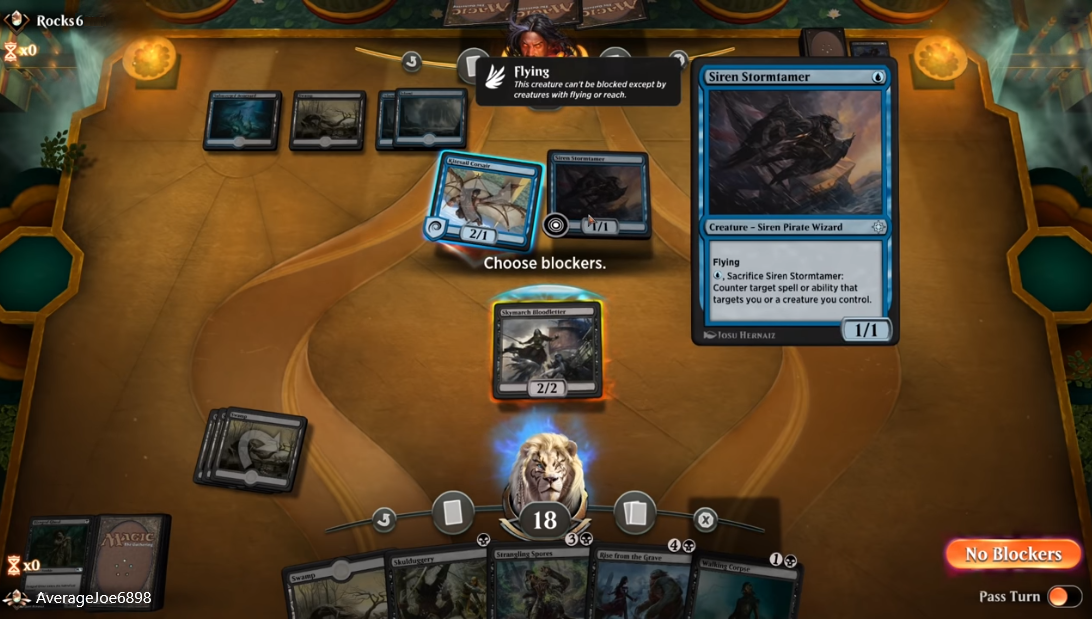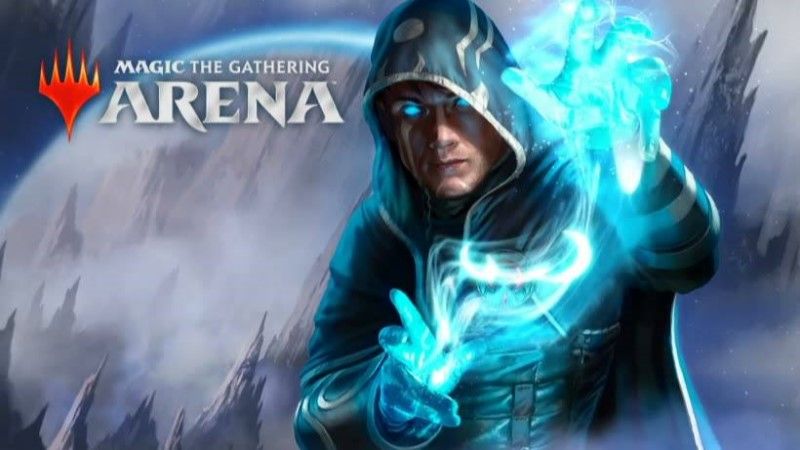Basics

Players can then choose from one of 12 avatars to represent them during matches. Each player can build a 40-60 card deck. While this may sound like a lot, one needs to bear in mind Unlike HearthStone, players can select an avatar irrespective of the type of deck that they have built. They will then receive their first quest, which, as with other online card games, will give them a reward.
Gameplay

Before the game begins, both players will be shown their starting hand of seven cards and will be given the option to replace their whole hand in favor of six new cards. The second player will drawer an extra card in the first round. The goal is, as with other Online card games, to reduce the opponent’s health from twenty to zero. They will do this by playing a combination of creature, planeswalker and spell cards, which are dictated by the number and type of land cards that they have played.
Players can play one land each turn. The amount of land that players have indicates the amount of mana that is accessible to a specific color. This is critical, as all creatures and spells have a mana cost-value that need to be met by the land cards that the player has on their side. The number of cards that a player can activate each round is also dictated by the amount of land-mana available. Therefore, a player can only play cards equaling the total number of mana that they have each turn. Those land cards will then be ‘tapped’ indicating that they have already been used that turn. So, if a player has three white land cards in play, they cannot play two white cards that each require two land-mana, as the total required mana is four. Tapped land cards are untapped at the start of the player’s next turn.
Phases
Players alternate between turns, with each turn being divided into phases. The beginning phase is when the player plays a new land card, activates instants and abilities, and draws a new card. They then move on to the Main Phase. The players can now activate spells and abilities or place new creatures or planeswalkers. The opponent can counteract these with instant spells and abilities. Newly summoned creatures suffer from Summoning Sickness and cannot attack on that turn unless they have an ability that states otherwise.
They then enter the Combat phase, where the active player can select which, if any, of their creatures will be attacking, as well as whether the creature will be targeting a particular planeswalker or the opponent (creatures cannot be directly targeted by other creatures). When the player is done, the opponent will be able to select other creatures or spells to protect the specified target. The opponent can select multiple creatures to defend a single target. However, the attacking creature can decide how to distribute their attack strength among the blocking creatures. If all of them are destroyed and the attacker still has some remaining attack power, that will damage the intended target. The limitation here, is that the opponent again has to tap into their land cards’ mana pool to cast instant spells.
The final phase is the attacking and blocking phase. Players will always be attacking the opponent, and the opponent can choose whether to have their creatures defend them against the attack. All creatures and planeswalkers that were damaged without being killed that turn, will be returned to full health (‘toughness’) at the start of the next player’s turn. As with HearthStone some creatures have special abilities, such as ‘charge.’ A fun aspect of this game is that there are out-of-turn instant spell cards that players can play to block attacks.
It is important to note that during turns, spells and abilities do not activate immediately. Rather, a stack is created, upon which the spells and counter-spells are placed by each player until no more spells are played.
The official MTG rules can be found here. They are more extensive than the summary provided above.
Ranks and Match-Making
Matchmaking is based both on a player’s rank, as well as their deck strength. This theoretically means that players with weaker decks will be matched against players who have decks of similar strength. While there has been a great deal of contention as to how this impacts the game for paying players, this feature is likely included to make the game more accessible for F2P players and will likely have less of an impact on match-ups as players reach higher tiers. Additionally, at the beginning of each month, players are rewarded between 1 Pack to 5 Packs and 1,000 gold for both their constructed and limited ranks. This means that if a player achieves Diamond in Constructed and Silver for Limited rank, they will receive both rewards at the conclusion of the season.
Acquiring New Cards
When players complete the tutorial for Magic: The Gathering Arena, they will receive five free decks. For the next few weeks they will receive more free decks until they have received a total of fifteen free decks. From there, they will be able to begin building and customizing their decks.
As with HearthStone, Players will receive daily quests that will award them with a reward of a varying amount of gold. This gold can then be used to purchase new booster packs. Players can also earn gold by wining matches and participating in special events.
Additionally, players can earn daily rewards, weekly rewards and once-off newbie quests. Using the promo code ‘PlayRavnica’ will award players with three free ‘Guild of Ravnica’ expansion packs, which is can be activated once per account.
Each pack contains eight non-repeating cards that are guaranteed to include: 1 Rare or Mythic Rare, 2 Uncommon and 5 Common cards. One of these might be a wild card. This will allow players to select any card in the game of the wild-cards rarity-type. This means that players will not have to worry about getting duplicate cards in a single pack, and that they will have a chance to receive the cards that they really want without having to buy as many packs.
Players can also use real-world currencies to buy gems, which they can also use to buy packs. However, although the gem purchases offer bundle option, there is no reduced pricing for mass-purchases. As with other online card-games, players will not be able to trade their cards.
New players will start off with a few free wild-cards. It is advisable that they get the hang o the game and do some research before exchanging them for new cards. Players will also earn free wild cards over time as they open more packs.
Another, riskier way of getting packs is to save up gold to enter the Draft and Sealed events. These cost a lot of gold that is only really earned back once players have won at least a certain number of cards. On the other hand, with draft mode, all cards that are drafted are added to the player’s collection, so they should hopefully end up with at least a few new useful cards.
As players can only add up to four copies of each card to a deck, fifth copies disappear towards an invisible vault. This vault will appear when the invisible counter is full, and the player will receive six wild cards; one mythic, two rare and 3 uncommon. This structure is likely to change by the official launch date.
The Magic: The Gathering Arena team plans on only releasing the latest card sets onto the online game, but as they plan on releasing around 1,000 new cards per year, players needn’t worry that they will get bored of their decks in a hurry. Therefore, players playing on the open beta will be able to purchase packs from the Core Set 2019, as well as four current expansions. As with the real-world decks, cards are rotated out each season, with only legal sets being accessible online. However, as with the real-world game, cards are only ‘legal’ for a limited period of time and will cycle out of playability within two years of their initial release date. This limitation does not apply in some game modes.
Classes and Color Factions
-
White – Tactical Assault
These cards generally focus on healing and protection. The creatures are generally combo-based. Therefore, while they are each generally quite weak, they become more powerful when their abilities are player off each-other. They also have a number of board-wipe and attack-prevention cards. Therefore, the focus of these decks is on overwhelming the opponent with numbers.
-
Blue – Arcane Inventions
Blue cards are more useful for a control-based play-style. Many of the spell cards center around counter-spell and -actions, as well as taking control of opposing creatures. However, many of the most effective cards are high cost, and therefore are most effective in late-game plays.
-
Black – Graveyard Bash
Black adopts an expedient playstyle of sacrifice and resurrection. While many of its cards are powerful, they are also often self-damaging and so require great skill and risk to play.
-
Red – Dragon’s Fire
Red contains more aggressive cards. This color focuses on attempting to establish early-game dominance. Many of red’s creature are immune to summoning sickness and can therefore be played on the first turn that they are played.
-
Green – Forest’s Might
As with white, much of the gameplay focuses on empowering other cards. Many of the cards are extremely powerful but are also often more supportive than useful for direct conflict. Dur to green’s creatures being very powerful, the spell cards are often focused at mana generation in order to enable the expensive cards to be played as early as possible.
Play Modes
Quick and Competitive Play – Free
Both of these modes are F2P and have no reward structures beyond quest fulfillment and win bonuses. However, these are still generous, as daily quests earn players either 500 or 750 gold, as well as win bonuses for up to ten wins. These include varying amounts of gold and individual cards. F2P players can easily earn enough gold to participate in the quick draft tournaments at least once per week. Additionally, players can use the promotional one-time use codes for free booster packs that are often issued when a new expansion is released. These are listed below.
Quick Draft – 5,000 gold
This mode is interesting as they will initially be paired with seven AI bots and will then open a 15-card pack of cards, from which they will select a card. The AI bots will then also take turns, until the cards are finished. This will be continued until the player has built a 40-card deck. Players will then go on to compete against other players. All cards of the cards in their deck will be added to the card pool regardless of how they perform in their matches. Players can either play up to three losses or seven wins, which will earn them a maximum of two more packs and 950 gems.
Competitive Draft – 1,500 Gems
This mode works almost like Quick Draft, except that each pack starts with 14-cards until the 40-card limit is met. Players will then play each opponent to either two wins or two losses, with two losses ending their run. The returns for winning are greater than Quick Draft, with a cap of five wins. However, players will already earn pack their gems as well as an additional 4 packs at three wins.
Competitive Constructed – 1,000 Gold
Players buy in to play with their own decks and break even at two wins, with a bonus three cards. They can either win up to five times and lose up to two matches for their run to end.
Sealed – 2,000 Gems
Players 6 Packs of fifteen cards each and then have to build a deck of between 40 – 60 cards from those packs. They cannot use cards from their personal collection. Players get to keep the cards from the packs, as well as any awards. Players can either win up to seven times or lose up to three matches, with tiered awards.
Legal Sets in MTG Arena
Only legal sets can be played in Standard MTG Arena. Each set or expansion released by Wizards of the Coast rotates out during the with the latest Fall release during the next year. This means that a set released in Fall, will have ~2-year lifespan, while the following three sets have progressively less play-ability in Standard. MTG Arena has announced plans to introduce a new format called ‘Eternal’ that will be similar to Hearthstone’s ‘Wild’ format (not their wording) that allows players to continue using their cards in that format once they cycle out of Standard. The major difference is that there is no ‘Classic’ variant set in MTG, so all legal cards will eventually cycle out of the current Standard set. This is why Wizards will sometimes print the same card in two sets.
Updates
On March 27, 2019, MTG Arena instituted a major update that allowed for new features , including:
- New purchasable content for either gold or gems, such as avatars, card sleeves (alternative card backs) and bundle content,
- Foil cards, which are alternative 3D renderings of existing cards. The player has to own the card in order to be used and can opt in or out of using it once it has been earned or bought, and
- A new on-boarding experience for new MTG Arena players including a skill-tree.
- Free MTG Arena promo codes for card sleeves and foils were released during MTG Arena’s first eSport Invitational event both online via Twitter and Instagram, as well as free card pack codes to IRL PAX visitors.
All MTG Arena Promo Codes
Promo Release Codes (3 booster packs each):
– PlayRavnica
– PlayAllegiance
-PlayWarSpark
-PlayM20
– PlayEldraine
2019 PAX Invitational MTG codes included:
– STARTERSTYLES
– SuperScry
– FoilFungus
– ParallaxPotion
– ShinyGoblinPirate
– SparkleDruid
Other Codes
– OverTheMoon
– INNERDEMON
– ShieldsUp
– WrittenInStone
– EnlightenMe
– LevelUp

